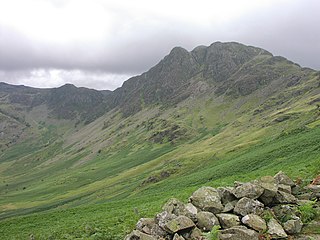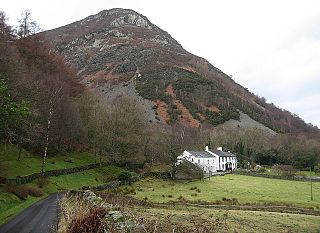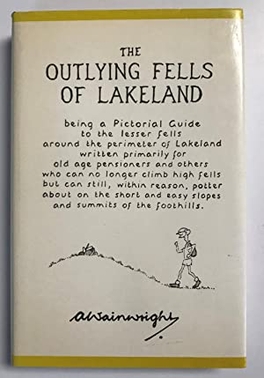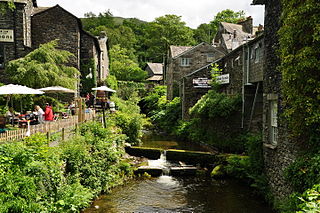Related Research Articles

Cumbria is a ceremonial county in North West England. It borders the Scottish council areas of Dumfries and Galloway and Scottish Borders to the north, Northumberland and County Durham to the east, North Yorkshire to the south-east, Lancashire to the south, and the Irish Sea to the west. Its largest settlement is the city of Carlisle.

Ulverston is a market town and civil parish in Westmorland and Furness, Cumbria, England. In the 2001 census the parish had a population of 11,524, increasing at the 2011 census to 11,678. Historically in Lancashire, it lies a few miles south of the Lake District National Park and just north-west of Morecambe Bay, within the Furness Peninsula. Lancaster is 39 miles (63 km) to the east, Barrow-in-Furness 10 miles (16 km) to the south-west and Kendal 25 miles (40 km) to the north-east.
Alfred Wainwright MBE, who preferred to be known as A. Wainwright or A.W., was a British fellwalker, guidebook author and illustrator. His seven-volume Pictorial Guide to the Lakeland Fells, published between 1955 and 1966 and consisting entirely of reproductions of his manuscript, has become the standard reference work to 214 of the fells of the English Lake District. Among his 40-odd other books is the first guide to the Coast to Coast Walk, a 182-mile (293-kilometre) long-distance footpath devised by Wainwright which remains popular today.

Kendal, once Kirkby in Kendal or Kirkby Kendal, is a market town and civil parish in the Westmorland and Furness district of Cumbria, England. It lies within the River Kent's dale, from which its name is derived, just outside the boundary of the Lake District National Park.

Windermere is a town in the civil parish of Windermere and Bowness, in the Westmorland and Furness district in the ceremonial county of Cumbria, England; it is within the Lake District National Park. The town lies about half a mile (1 km) east of the lake, Windermere, from which it takes its name. In 2021 it had a population of 4,826.

Grasmere is a village and former civil parish, now in the parish of Lakes, in the Westmorland and Furness district of Cumbria, England, and situated in the centre of the Lake District and named after its adjacent lake. Grasmere lies within the historic county of Westmorland. The Ambleside and Grasmere ward had an estimated population of 4,592 in 2019. William and Dorothy Wordsworth, the 'Lake Poets', lived in Grasmere for 14 years and called it "the loveliest spot that man hath ever found."

High Street is a fell in the English Lake District. At 828 metres (2,717 ft), its summit is the highest point in the far eastern part of the national park. The fell is named after the Roman road that ran over the summit.

Haystacks, or Hay Stacks, is a hill in England's Lake District, situated at the south-eastern end of the Buttermere Valley. Although not of any great elevation, Haystacks has become one of the most popular fells in the area. This fame is partly due to the writings of Alfred Wainwright, who espoused its attractions and chose it as the place where he wanted his ashes scattered. Its large, undulating summit contains many rock formations, tarns and hidden recesses.
Edward Hunter Davies is a British author, journalist and broadcaster. His books include the only authorised biography of the Beatles.
High Rigg is a small fell located in the English Lake District, approximately three miles southeast of the town of Keswick. It occupies an unusual position, surrounded on all sides by higher fells but not connected by any obvious ridge. This separation from its fellows ensures that it is a Marilyn.

Barf is a fell in the north-western Lake District in Cumbria, UK. It stands on the south-western shore of Bassenthwaite Lake. Barf is well known for a whitewashed pillar of rock on the lower slopes, the so-called "Bishop's Rock" or "Bishop of Barf". The name is thought to be a derivative of "burgh".

A Pictorial Guide to the Lakeland Fells is a series of seven books by A. Wainwright, detailing the fells of the Lake District in northwest England. Written over a period of 13 years from 1952, they consist entirely of reproductions of Wainwright's manuscript, hand-produced in pen and ink with no typeset material.
Thomas William Birkett better known as Bill Birkett is an English civil engineer, climbing writer, photographer, rock climber, and mountaineer, from the Lake District, Cumbria, who has undertaken many expeditions around the world. The 541 peaks of the lake district listed in one of his books are known as Birketts in his honor.

Great Crag is a fell in the English Lake District, located near the hamlets of Rosthwaite and Stonethwaite in Borrowdale.

Shipman Knotts is a fell in the English Lake District in Cumbria, England. It reaches a height of 587 metres (1,926 ft) and is situated in one of the quieter areas of the national park, 2 kilometres north-east of Kentmere village. Although not one of the best-known Lake District fells, it earned a separate chapter in Alfred Wainwright’s Pictorial Guide to the Lakeland Fells due to “Its characteristic roughness. .. rocky outcrops are everywhere on its steep slopes”.
Walna Scar is a hill in the English Lake District, lying just south of a pass of the same name in the Coniston Hills. Its summit at 2,035 feet (620 m) is only slightly higher than the pass.

The Outlying Fells of Lakeland is a 1974 book written by Alfred Wainwright dealing with hills in and around the Lake District of England. It differs from Wainwright's Pictorial Guides in that each of its 56 chapters describes a walk, sometimes taking in several summits, rather than a single fell. This has caused some confusion on the part of authors attempting to prepare a definitive list of peaks. The Outlying Fells do not form part of the 214 hills generally accepted as making up the Wainwrights, but they are included in Category 2B of the Hill Walkers' Register maintained by the Long Distance Walkers Association.
The Westmorland Gazette is a weekly newspaper published in Kendal, England, covering "South Lakeland and surrounding areas", including Barrow and North Lancashire. Its name refers to the historic county of Westmorland. The paper is now owned by the Newsquest group, forming part of Westmorland Gazette Newspapers, which includes the weekly freesheet South Lakes Citizen and other titles. It has an office in Ulverston in addition to its Kendal base. The circulation is about 7,500. It changed from broadsheet to compact format in August 2009. The editor, Vanessa Sims, also edits Cumbrian titles the Mail, the News & Star, The Cumberland News, the Whitehaven News, and the Times & Star.
The Lakeland Book of the Year, also known as the Hunter Davies Lakeland Book of the Year is an award given annually for a book "set in or featuring Cumbria in some way", and is named for the Lake District of north west England. It was founded by writer Hunter Davies in 1984 and is administered by Cumbria Tourism. Davies was one of the judges from 1984 to 2022. In 2023, following Davies's retirement from the role, the judges were Fiona Armstrong, Eric Robson, Michael McGregor, director of Wordsworth Grasmere, and "guest judge" Rachel Laverack from Cumbria County Council. The prizes are traditionally announced at a gala lunch in June, although in 2020 the proceedings took place online because of COVID-19.

Stock Ghyll, also known as Stock Gill, Stock Gill Beck and Stock Beck, is a stream in South Lakeland, in the ceremonial county of Cumbria and the historic county of Westmorland. It flows about four miles from Red Screes through the town of Ambleside to the River Rothay. Its course includes two long-popular tourist attractions, Stockghyll Force and Bridge House. Stock Ghyll has been painted by J. M. W. Turner, John Ruskin, Kurt Schwitters, and many others. Its name derives from Old English stocc, 'tree-trunk', and Old Norse gil, 'a deep glen'.
References
- ↑ "Cartoonist celebrates 30 years of illustrating Gazette news stories". The Westmorland Gazette. 24 April 2014. Retrieved 28 July 2024.
- ↑ "Lakeland Book of the Year | Cumbria Tourism". www.cumbriatourism.org. Retrieved 28 July 2024.
- ↑ "When Hunter Davies's controversial Lake District guidebook pulled no punches - The Keswick Reminder". 7 April 2024. Retrieved 28 July 2024.